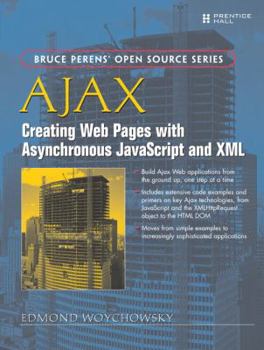Ajax: Creating Web Pages with Asynchronous JavaScript and XML
The Easy, Example-Based Guide to Ajax for E very Web Developer Using Ajax, you can build Web applications with the sophistication and usability of traditional desktop applications and you can do it... This description may be from another edition of this product.
Format:Paperback
Language:English
ISBN:0132272679
ISBN13:9780132272674
Release Date:January 2006
Publisher:Prentice Hall PTR
Length:384 Pages
Weight:1.75 lbs.
Dimensions:1.0" x 7.1" x 9.2"
Customer Reviews
4 ratings
Awesome
Published by Thriftbooks.com User , 17 years ago
This book was far more informative than I imagined it would be, and I very highly recommend this to anyone who wants to get into Ajax. Also lots of good humor throughout the book. Great!
An easily-understood, basic guide
Published by Thriftbooks.com User , 18 years ago
AJAX: CREATING WEB PAGES WITH ASYNCHRONOUS JAVASCRIPT AND XML by Edmond Woychowsky is for web programmers who want to make the most of Ajax's processing powers. From understanding and using back-end code to developing Ajax libraries for code re-use and reference and linking elements with attributes and descriptions, here's an easily-understood, basic guide to not just Ajax, but other open source technologies and how they interact, from Firefox to MySQL. Diane C. Donovan California Bookwatch
Great Introduction to Ajax
Published by Thriftbooks.com User , 18 years ago
Ajax has hit the bookstores hard the past 6 months and there a lot of books on the market. To try and differentiate them is difficult since it is still a fairly new technology (or implementation of existing technologies actually) and people are trying to understand how to use it and use it properly. The Ajax: Creating Web Pages with Asynchronous JavaScript and XML is a little different than the rest and that is a good thing. Here's why... 1) It doesn't just go right into showing you how to use the XMLHttpRequest object in the usual "Hello World" examples. Its goes into detail how normal scripting works with web pages and shows the differences in using an Ajax implementation and what it can do it for you. 2) It doesn't try to sell you that using Ajax is always better. It explains how other techniques (better or worse) can be used to do similar results: HTML frames and IFRAMES. 3) It teaches you the technologies that are used in Ajax in case you are just starting out. It gives a great primer to XHTML tags,JavaScript basic syntax, the DOM and XML. 4) The examples on Ajax use open source technologies (PHP and MySQL) and really explain how to use these server-side technologies so if you're unfamiliar with them you won't get lost. Was great because myself am a ASP.NET developer, but I had no problem following the examples using PHP code. 5) A very detailed explanation of the XMLHttpRequest object (chapter 7 and 8). Other books I have read on Ajax briefly go into this very important object but this book really explains it methods and properties and how to use it correctly with XML DOM, RSS, and Web Services. 6) Covers XSLT, which many books do not. Those are just a few points why this book is a great, complete introduction to Ajax and why it should be in your bookshelf. I highly recommend it.
enhanced JavaScript
Published by Thriftbooks.com User , 18 years ago
As an aside, the author embeds humourous throwaway remarks in this text, that are often well worth hunting for and reading for your own amusement. The book goes through the syntax of Ajax. Which essentially is the syntax of JavaScript itself. Ajax does not really invent a new language. Its innovation comes in how it lets you combine existing approaches in a novel manner. This means that you might consider this book as an advanced text on JavaScript, and how to combine it with using HTML and XML. External to this book, there is a feeling on the Web that Ajax is really a clever marketing of JavaScript. In any event, the methods described in the book should be easy to an experienced programmer. Especially if you have had any background in even minimally using JavaScript and HTML. The most intricate parts of the book relate to using XPath and XSLT. These have been around for several years. But prior to Ajax, their uptake seems to have been minimal. Perhaps due to their complexity. With Ajax, there is now a prospect that XPath and XSLT might actually see greater use. The author has correctly included them in the book, for completeness. However, if you are new to Ajax, I'd suggest avoiding these chapters on a first pass.





